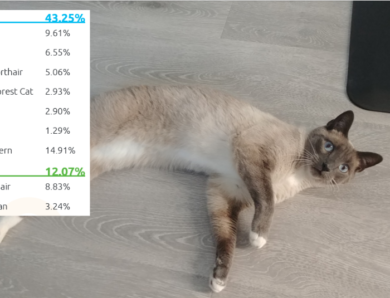
The Truth About Litter Boxes
Cats need litter boxes. Even cats that go outside and do much of their business out there need a litter box in the house for when they’re home and have to go.
There are all kinds of “rules” when it comes to litter boxes and cats – from how big your litter box should be to how many of them you have. And while we don’t want to disagree with the experts, we have found that many of these rules don’t have to be so hard and fast.
Our cats tell us what we need to do when it comes to their litter boxes. We’ve learned from their behavior how many litter boxes we need, whether they can be closed or must be open, and how often they need to be fully cleaned.
Learn more about why you should never flush cat poop down the toilet.
A lot of work goes into being a good cat parent, but you don’t always have to do everything the experts tell you to do.
We’ve rounded up the basic rules of cat litter boxes, and then shared how we break almost all of them.
(Editor’s Note: Breaking the rules may not work for you. Some cats are more fastidious than others and may very well demand you do everything by the book.)
How big should your litter box be?
Rule: At least one and a half times the length and at least as wide as your cat is long.
Truth: Generally speaking, we agree. A bigger litter box is always better. Even if you’re buying for your new kitten, spend a little extra for the bigger box. You don’t know how big a cat your kitten is going to grow into. And you never know when you might just get another cat. (They’re kinda like Pringles. It’s hard to have just one!)
Large or overweight cats also can struggle in smaller litter boxes, so you always want to have something than can accompany even the biggest cat without them having to step outside to cover their business.
We also find that cleaning a bigger box is easier. We’re less likely to bump the scoop into the side, spilling dirty litter everywhere. We’re also less likely too scrape our hands when cleaning.
Covered or uncovered?
Rule: Many experts will tell you that cats don’t like covered litter boxes. That covered boxes make them feel claustrophobic. These experts recommend open litter boxes, though they’ll often suggest getting one with high sides to prevent litter from getting scattered everywhere.
Truth: Some cats don’t like covered litter boxes, that is true. And if you’re unlucky enough to have such a cat you may have to do an uncovered box. However, at Keeping It Pawsome, other than back in the 80s when all litter boxes were uncovered, we’ve always had covered boxes for our cats and never once had a problem.
We agree some cats might find them claustrophobic, so don’t get a tiny one! Invest in a large one, even if you’re starting with a kitten.
But what about the arthritis argument, you ask? Many experts recommend getting an uncovered litter box with at least one short side so that a cat with arthritis can get inside without pain.
We say, unless you have a cat with arthritis don’t worry about. You can cross that bridge if you get to it.
How many litter boxes should you have?
Rule: One litter box for each cat in the home, plus one extra.
The general thought behind this is that no cat will be stuck without a litter box because they’re all occupied.
Truth: First of all, if you have one cat, you don’t need two litter boxes. Unless you’ve put a litter box in a room that your cat will be locked out at some point during the day, one litter box is just fine.
As for multiple cats, we have six. Maybe, just maybe, two cats have used litter boxes at the same time. Generally, they’re all on their own schedule and there’s little to no overlap.
We have four litter boxes. They’re spread around the first floor of our house, with two in opposite sides of the same room. We’ve never seen a single one of our cats clenching his legs together waiting for a box to become available. There’s always one open.
And while, sure, don’t get six cats if you live in an apartment and don’t have room for multiple litter boxes. Feel free to have two cats and stick with one litter box. Or have three or four cats, but just have two litter boxes.
Your cats will let you know what the ideal number for them is. When we had four cats, we tried four litter boxes. One of them never got used, so we reduced the number to three. We only went back up to four when we added two new cats.
Start with what feels appropriate to you and then let your cats’ usage of the boxes determine whether you add or subtract one.
Where should you put your litter boxes and can you put two litter boxes next to each other?
Rule: There should be at least one litter box on every floor of your home that your cat(s) has access to; there should not be more than one litter box in any given room.
Truth: Unless every single one of your cats is a bully that likes to pick on all the other cats, you can have more than one litter box in a room. In some cases, you can even have litter boxes next to each if necessary. Do what feels right to you — your cats will let you know if they don’t like it and then you can make changes.
We have a two-floor house, but we only recently started using our second floor. Because our cats grew up with their litter boxes on the first floor, they don’t seem to mind that there’s no litter box in the one room upstairs they now have access to.
How often should you scoop your litter box?
Rule: At least once every day.
Truth: This is the only litter box rule we agree with, but even here we think there’s wiggle room. If you’ve only got one cat and you want to skip a day, honestly, we don’t see a problem with that. Again, your cat will let you know if that’s one day too much.
We once accidentally went three days without cleaning our cats’ favorite litter box, and one of our cats let us know quite clearly that she wasn’t happy. The minute we went back to daily cleanings, she started using it again and we haven’t had a problem since.
Additionally, some types of litter are better for skipping a day than others. Clay litters generally retain odor more easily than clumping litter. If your cat doesn’t voice his displeasure, your nose might.
Before you throw away that whisker you found on the ground, find out how one jeweler transforms cat whiskers into stunning works of art.
How often should you change out all the kitty litter?
Rule: Once or twice a week for clay litter; every two to three weeks for clumping litter.
Truth: We don’t use clay litter. Haven’t used it in years, not since clumping litter was invented, so we can’t honestly advise on how often to swap it out (though we seriously doubt twice a week is truly necessary).
We do use clumping litter and we do a complete litter swap and box cleaning twice a year. Yes! Twice a year. And we’ve never had a problem. (We use our regular dish soap to clean the litter box, so there are no harsh chemicals and the scent of the cleaner isn’t overpowering.)
How often you choose to clear out all the old litter and clean your litter box should depend on two things. Has it started to smell and/or are your cats bothered by it?
We have never been able to justify discarding a litter box’s worth of expensive clumping litter if there’s no smell and our cats have absolutely no issue using it. One way we accomplish this is by occasionally letting the litter box get pretty low on litter. We don’t push it too far; we know our cats aren’t happy if there’s not enough litter in the box. But if we get it low enough and then add in lots of new litter, it’s almost like we’ve done a complete swap.





